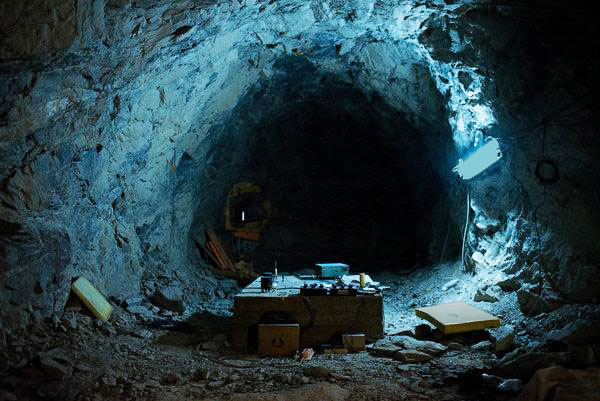
 The Neutrino Trappers
The Neutrino Trappers
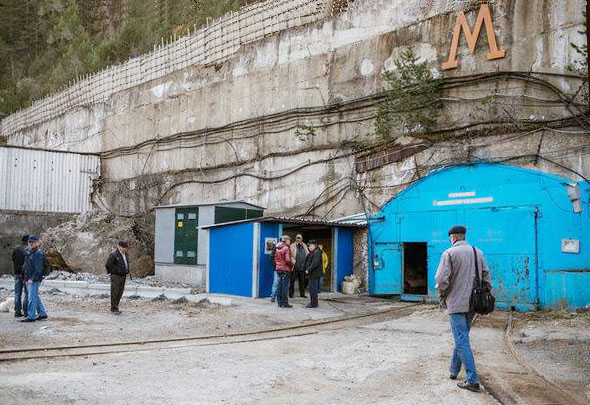
Deep in a mountain in southern Russia, scientists are tracking one of the universe’s most elusive particles.
Just over the border from Georgia, in the Caucasus Mountains of southern Russia, lies a small town called Neytrino. For the last half-century, its main business has been the study of the tiniest insubstantial bit of matter in the universe, an ephemeral fly-by-night subatomic particle called the neutrino.
This is the home of the Baksan Neutrino Observatory, a warren of tunnels and laboratories burrowed two miles into a mountain, sheltered from the outside universe and cosmic rays underneath 12,000 feet of rock. There vats of liquid wait to record the flight of neutrinos from the center of the sun, from exploding stars, atomic reactors and the Big Bang itself, carrying messages through time.

A laboratory in an underground gallery at the Baksan Neutrino Observatory.
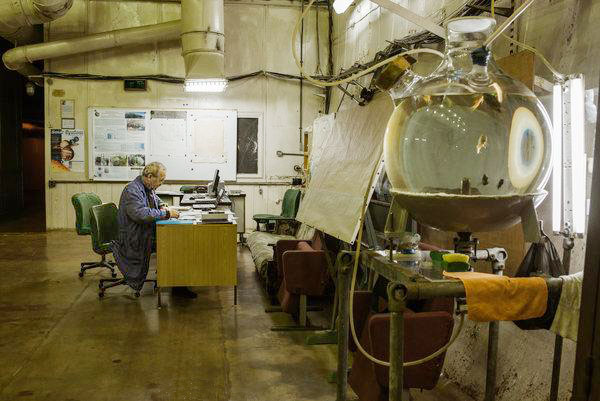
In the gallium-germanium telescope laboratory, a worker crunches number. Fish swimming in an aquarium serve both as companions and as an early warning system in case something goes awry with the laboratory's radioactive materials.
The most delicate measurements so far indicate that an individual neutrino weighs less than a millionth what an electron weighs. Baksan is not the only place dedicated to their surreal pursuit.
The men and women in these photographs, taken by Maxim Babenko last year, share an underground union with scientists scattered around the world in equally deep places: the Sanford Underground Research Facility in the former Homestake gold mine in Lead, S.D.; the Gran Sasso National Laboratory, beneath the mountain of that name in Italy; the Sudbury Neutrino Observatory in Ontario, Canada; the Super-Kamiokande, deep within Mount Ikeno, Japan; and IceCube, an array of detectors buried in ice at the South Pole.
All of them are trying to listen to quantum whispers about the nature of reality.
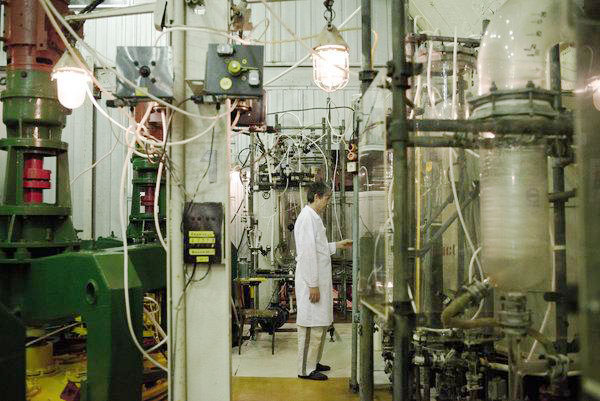
Nail Khairnasov, lead engineering technologist of the gallium-germanium telescope, has been running these devices for nearly 30 years. The telescope, built in the late 1980s, contains 60 tons of gallium.
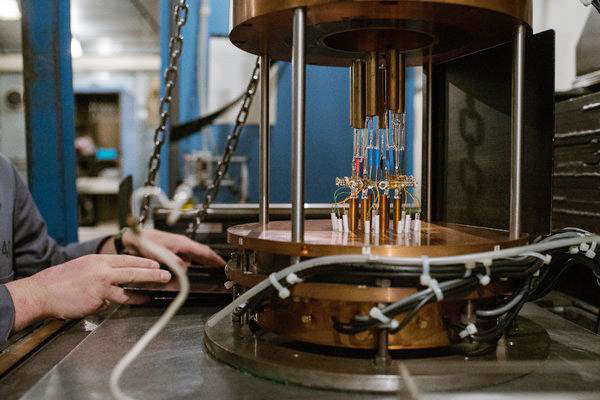
Valery Gorbachev, a senior researcher, setting up counters with radioactive isotopes of germanium. Each counter contains just a few dozen germanium atoms.
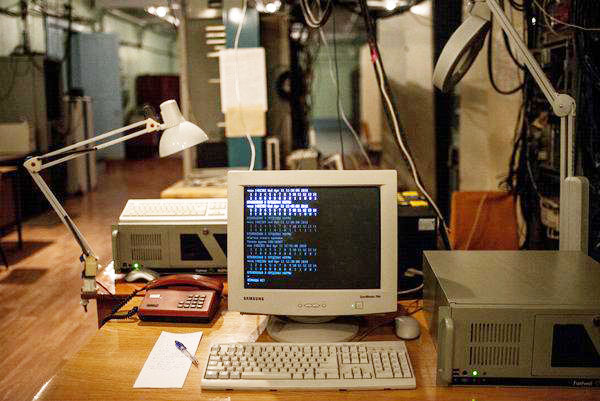
Vintage computers keep track of events observed in the observatory.
One of Baksan’s biggest claims to fame to date was to catch neutrinos emitted by thermonuclear reactions in the center of the sun in nearly 60 tons of liquid gallium. The experiment, called S.A.G.E., for Soviet-American Gallium Experiment, proved that scientists actually do know what powers our favorite star, source of our life and light.
Since the fall of the Soviet Union, the scientists in Baksan have had to fend off both thieves and the Russian government to keep their gallium, an element that goes for some $500 a kilogram.
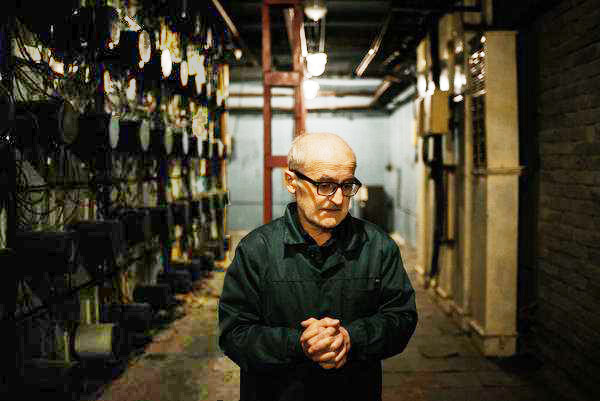
Musabi Boliev runs the underground scintillation telescope in the observatory, an enormous structure built in 1977 that detects passing neutrinos and measures their energy and direction.

A bust of Lenin and a poster reading “Glory to Soviet Science” are vestiges of the observatory’s origins.
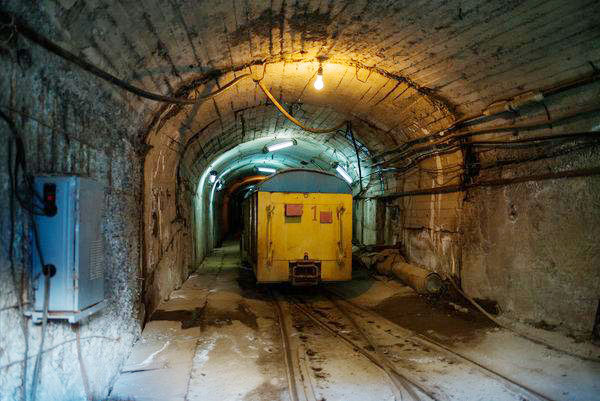
Trolleys convey workers to and from the surface and to spaces within the underground observatory. More than 250 people work at Baksan, 30 of them scientists.
Physicists know that neutrinos come in at least three flavors, known as electron, muon and tau neutrinos, depending on their subatomic origin. To add to the confusion, neutrinos have a kind of quantum superpower: They can molt from one type to another, sort of like a jail escapee changing clothes as he flees. An electron neutrino, say, can emerge from a nuclear reactor in one place and appear in a detector somewhere else as a muon neutrino. This complicates the cosmic accounting of these creatures.
Physicists are arguing intensely these days over whether there is evidence for a fourth type, called sterile neutrinos. That is the object of a new experiment called B.E.S.T., for Baksan Experiment on Sterile Transitions, now underway in the rusty Baksan tunnels.

Above ground, children from the village of Neytrino dream of the World Cup. The local secondary school has about 40 students.

In Elbrus, a village adjacent to Neytrino, children in traditional garb wait for an evening of performance and dancing to begin, a regional pasttime.

Balkar dancing in Elbrus.
Although neutrinos are the lightest and flimsiest and perhaps most fickle particles of the universe, they are also among the most numerous, outnumbering the protons and electrons that make up us and ordinary matter by a billion to one. And so neutrinos contribute about as much mass to the universe as the visible stars.
An extra population of neutrinos discovered by scientists in a cave in the Caucasus would affect basic calculations of the expansion of the universe.
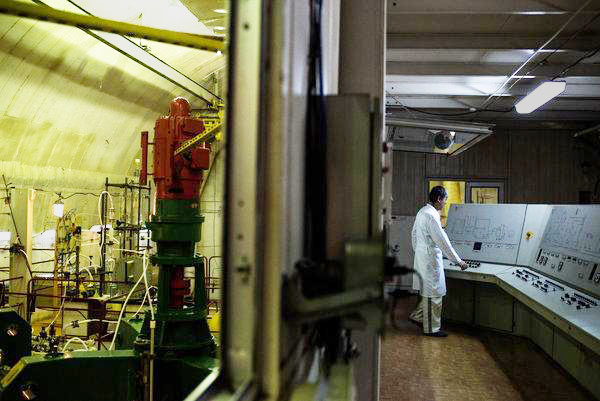
Despite low salaries and a constant hunt for funds, scientists like Dr. Khairnasov quietly carry on the work of understanding the fickle particle.
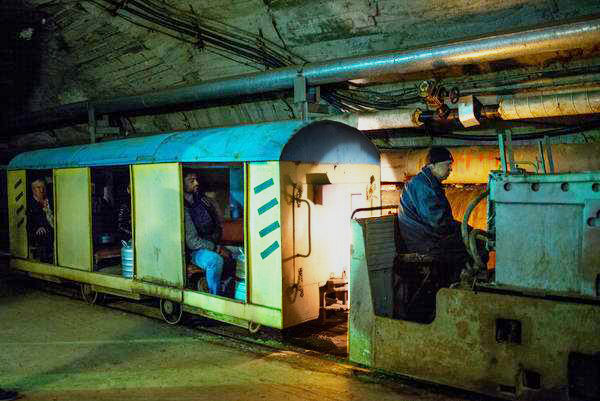
One of the observatory’s underground trolleys.

A bus conveys Baksan workers — most of whom are mechanics, dispatchers and other support personnel — and others to the nearby town of Tyrnyauz, where many of them live.

In the other direction, at the road’s terminus, is a popular ski resort on Mt. Elbrus’s slopes.
The discovery this month of a high-energy neutrino from a far distant galaxy passing through the IceCube detector at the South Pole elicited headlines around the world.
Meanwhile, unaware that they are being harassed by extraterrestrial visitors, horses graze outside Baksan, and life goes on, whether we understand it or not.
Dennis Overbye joined The Times in 1998, and has been a reporter since 2001. He has written two books: "Lonely Hearts of the Cosmos, The Scientific Search for the Secret of the Universe" and "Einstein in Love, A Scientific Romance."
| ÆÅËÀÅÌ ÂÑÅÌ ÍÎÂÛÕ ÒÂÎÐ×ÅÑÊÈÕ ÓÑÏÅÕÎÂ, Ñ×ÀÑÒÜß È ÏÐÎÖÂÅÒÀÍÈß! |
For the first time, astronomers followed cosmic neutrinos into the fire-spitting heart of a supermassive blazar.

The IceCube Neutrino Observatory in Antarctica, where the tiny particle believed to have originated in a supermassive black hole was observed last year. CreditFelipe Pedreros, IceCube/NSF
It was the smallest bullet you could possibly imagine, a subatomic particle weighing barely more than a thought. It had been fired out of a gravitational gun barrel by a cosmic blunderbuss, a supermassive black hole.
On Sept. 22, 2017, a particle known as a neutrino zinged down from the sky and through the ice of Antarctica at nearly the speed of light, setting off a cascade of alarms in an array of detectors called IceCube.
Within seconds IceCube had alerted an armada of astronomical satellites, including the Fermi Gamma-ray Space Telescope. That spacecraft traced the neutrino back to an obscure dot in the sky, a distant galaxy known as TXS 0506+056, just off the left shoulder of the constellation Orion, which was having a high-energy outburst of X-rays and gamma-rays.
While astronomers around the world scrambled to their telescopes to get in on the fun, the IceCube scientists scoured their previous data and found that there had been previous outbursts of neutrinos from the galaxy, which they nicknamed the “Texas source,” including an enormous neutrino outburst in 2014 and 2015.
Astronomers said the discovery could provide a long sought clue to one of the enduring mysteries of physics and the cosmos. Where does the rain of high-energy particles from space known as cosmic rays come from?
The leading suspects have long been quasars. They are supermassive black holes in the centers of galaxies where matter and energy get squeezed like toothpaste out of the top and bottom of a doughnut of doomed swirling material in a violent jet.
Now they know at least one in which that seems to be the case. TXS 0506+056 is a type of quasar known as a blazar, in which our line of sight from Earth is along the jet — right down the gun barrel. The term blazar comes partly from BL Lacertae, a starlike object that turned out to be the first of these objects ever recognized.
“We have found the first source of cosmic rays,” said Francis Halzen, of the University of Wisconsin, Madison, and IceCube’s director, in an interview.
“Where exactly in the active galaxy, the neutrinos are produced will be a matter of debate,” he added in an email. “It is clear that the supermassive black hole provides the accelerator power,” he said, but how is a mystery.

A view of the BL Lacertae object from which blazars derive their names.CreditRenato Falomo
IceCube, an international observatory run by 300 scientists from 12 countries, consists of more than 5,000 sensitive photomultiplier tubes embedded in grid encompassing a cubic kilometer of ice at the South Pole. When a neutrino very, very, very, very, very rarely hits an atomic nucleus in the ice, it produces a cone of blue light called Cerenkov radiation that spreads through the ice and is picked up by the photomultipliers.

An artist's rendering of the supermassive black hole near Orion, shooting its narrow jet of high-energy matter in Earth's direction.CreditReuters
IceCube was built, Dr. Halzen said, to find the source of cosmic rays, and the observatory has been recording neutrinos ever since it started working in 2011, but had not been able to pinpoint the sources of any of them until now. One reason, he said, was that the scientists had assumed the sources would be nearby, perhaps even in our own Milky Way galaxy.
But TXS 0506+056, the Texas source, is very far away, some 4 billion light-years. It is one of the brightest objects in the universe, said Dr. Halzen.
The neutrino that set off the alarm in 2017 had an energy of some 300 trillion electron volts, by the units of energy and mass that physicists prefer. Which means it had been produced by a proton that had been a booster to that energy, nearly 50 times the energy delivered by the Large Hadron Collider at CERN, the biggest particle accelerator on Earth.
Call it the Large Hadron Collider in the sky. Presumably it is some kind of supermassive black hole rumbling in the heart of that distant galaxy. For now, how this cosmic accelerator works in detail is a mystery
Azadeh Keivani, of Pennsylvania State University and lead author of the Astrophysical Journal paper that tried to model it, wrote that “typically the mass of blazars are about 1 billion solar masses.”
Why is this source so special? Why is it so far away? Those are the questions that need to be answered, Dr. Halzen said. Do such blazars produce all the neutrinos and all the cosmic rays we see?
Luckily an enormous amount of data has been collected from the world’s telescopes over the last few months in what astronomers like to call “multi-messenger astronomy” to give hope of making progress on these and other questions. And the inventory of cosmic neutrinos is only beginning. IceCube has a large and long agenda.
Noting that the Texas source has only erupted twice in the last nine years, Dr. Halzen said, “This is not going to be an everyday event.”
IceCube cost about $250 million to build and almost nothing to operate, because it is all frozen in the ice. Dr. Halzen said he could now operate it from his laptop.
They keep two people on site at the South Pole, he said. “Ideally they have nothing to do.”
51Comments
The Times needs your voice. We welcome your on-topic commentary, criticism and expertise.

It’s not a field that universities or learned societies recognize, but it fits the investigation of how reservoirs in the skin of citrus fruit burst and shoot out micro-jets of aromatic oil at more than 30 feet per second.
Andrew Dickerson and his colleagues at the University of Central Florida in Orlando investigated the phenomenon purely out of curiosity. Anyone who has handled a lemon or a navel orange may have noticed that when the skin is bent, a little bit of oil comes out in a tiny spritz. These are to be distinguished from the wayward squirts of juice that can hit a dinner companion when you are trying to add a dash of lemon to your sole.
The scientists used high-speed videography to track how the process works and found sacs of oil in the relatively soft part of the skin just below the more rigid outer layer. They used pliers to bend skin of several citrus fruits and found that at a certain point, the stress on the skin causes a break and the oil reservoir empties in a burst.
Micro-jets are found in other plants and in animals as well, such as spitting termites and spiders. Why citrus plants show this action when the skin is bent in an extreme way isn’t known, although the oils are toxic to some insects, plants and microbes. The micro-jet phenomenon is the reason that bartenders twist an orange or lemon peel to release the flavor, but that is not likely to have played a part in their evolution.
ADVERTISEMENT
The experiments, reported in the Proceedings of the National Academy of Sciences, may be helpful in fields like medicine or commercial printing or even in devising monitors for stress in bridges. For instance, a micro-jet sensor might indicate when too much stress is put on part of a bridge, bursting and spraying a dye.
That’s speculation. Dr. Dickerson said that he had undertaken the investigation because of conversations eight years ago with David Hu of Georgia Tech when Dr. Dickerson was an undergraduate working in Dr. Hu’s lab.
And one of the things he takes away from the findings, after viewing the high-speed videos, is that everyday life is filled with hidden marvels, “ubiquitous examples of natural beauty.” “How many times have you peeled an orange?” he asked. “How many other things in life pass us by and we don’t appreciate them?”